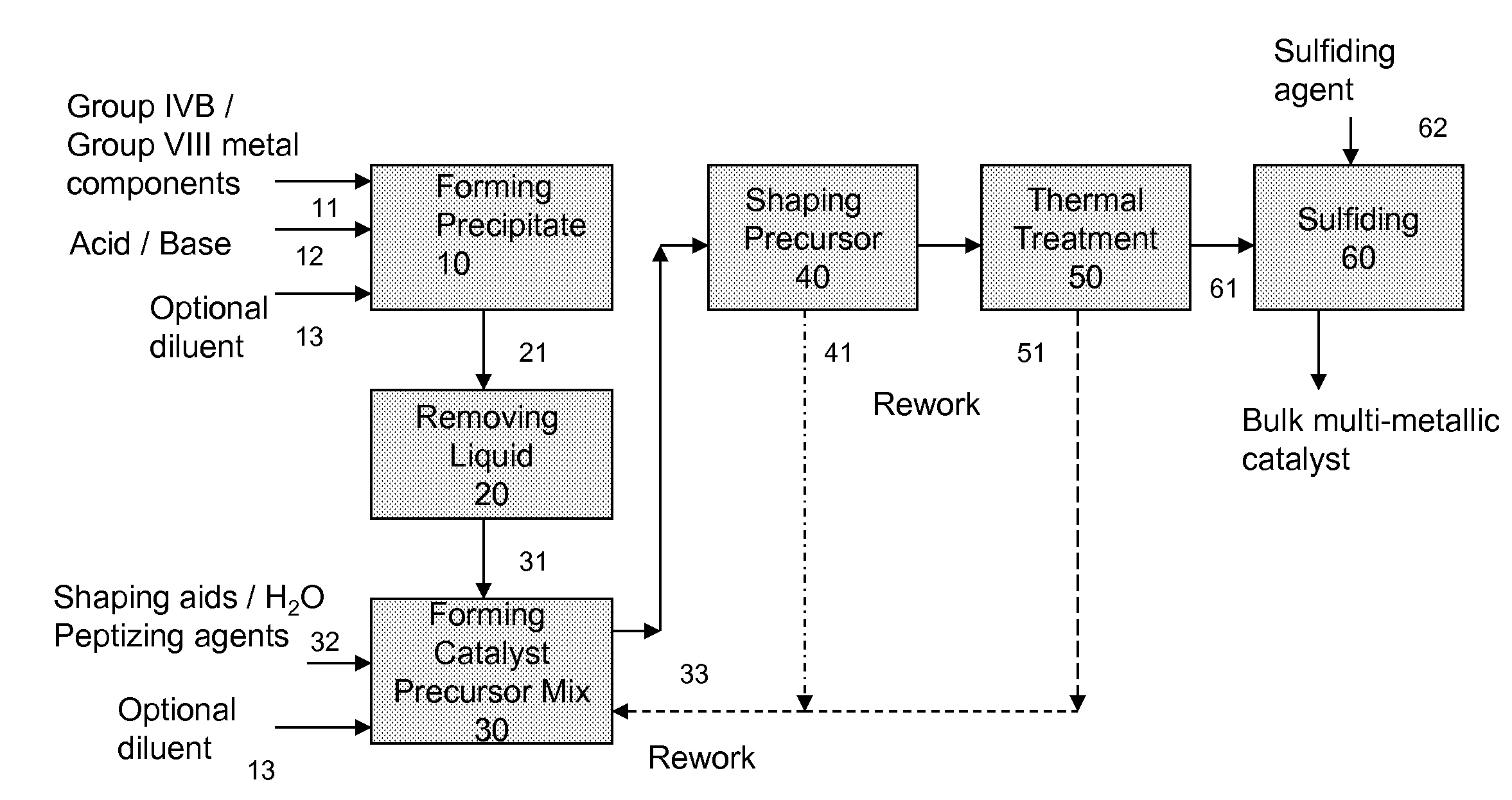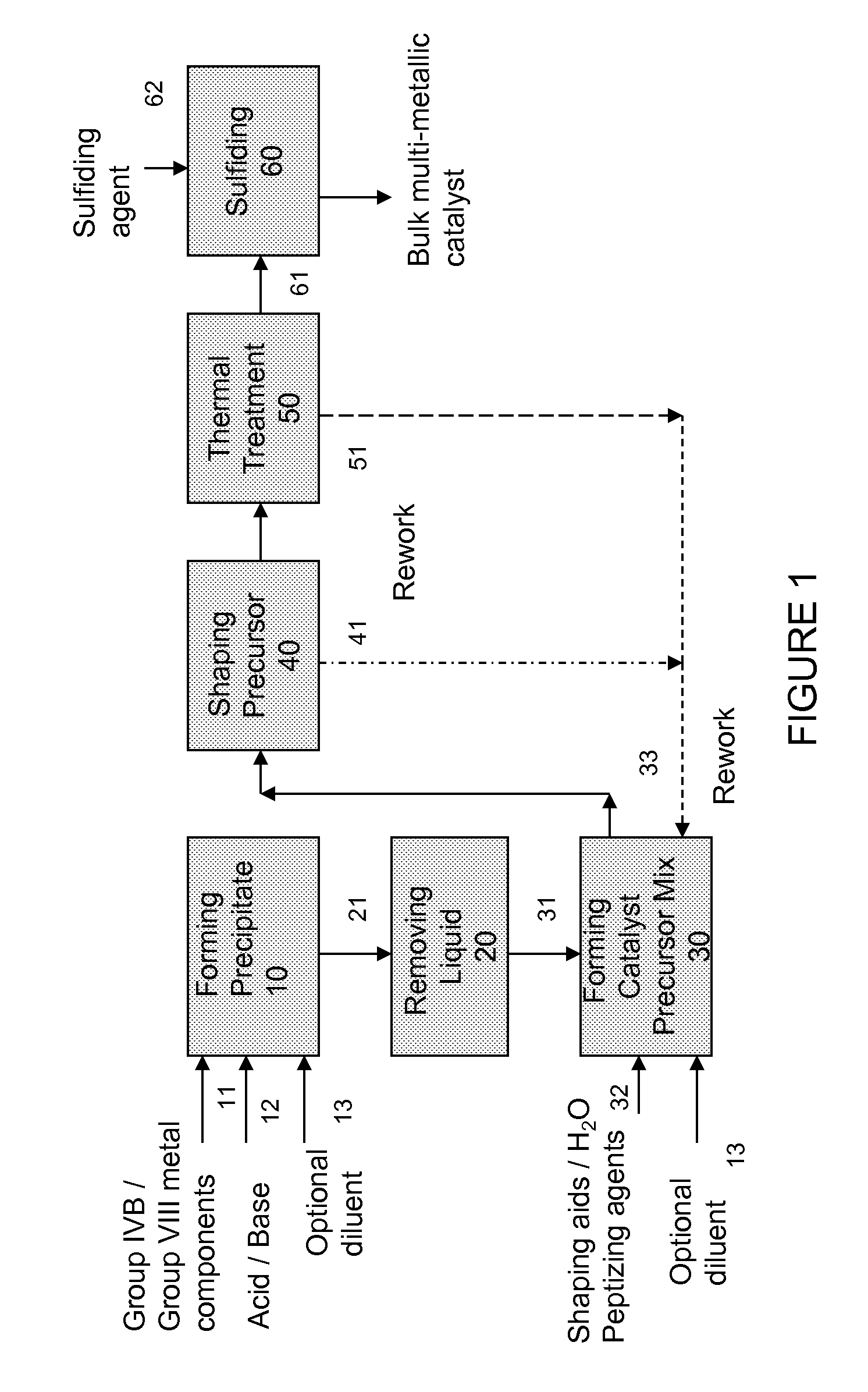Hydroconversion Multi-Metallic Catalyst and Method for Making Thereof
a multi-metallic catalyst and catalyst technology, applied in the direction of physical/chemical process catalysts, metal/metal-oxide/metal-hydroxide catalysts, organic compounds/hydrides/coordination complexes, etc., can solve the problem of reducing the utilization efficiency of the bed, reducing the effectiveness of the catalyst bed, and reducing the efficiency of the bed
- Summary
- Abstract
- Description
- Claims
- Application Information
AI Technical Summary
Benefits of technology
Problems solved by technology
Method used
Image
Examples
example 1
Ni—Mo—W-Maleate Catalyst Precursor
[0057]A catalyst precursor of the formula (NH4) {[Ni2.6(OH)2.08(C4H2O42−)0.06] (Mo0.35W0.65O4)2} was prepared as follows: 52.96 g of ammonium heptamolybdate (NH4)6Mo7O24.4H2O was dissolved in 2.4 L of deionized water at room temperature. The pH of the resulting solution was within the range of 2-3. 52.96 g of ammonium heptamolybdate (NH4)6Mo7O24.4H2O was dissolved in the above solution. The pH of the resulting solution was within the range of 5-6. 73.98 g of ammonium metatungstate powder was then added to the above solution and stirred at room temperature until completely dissolved. 90 ml of concentrated (NH4)OH was added to the solution with constant stirring. The resulting molybdate / tungstate solution was stirred for 10 minutes and the pH monitored. The solution had a pH in the range of 9-10. A second solution was prepared containing 174.65 g of Ni(NO3)2.6H2O dissolved in 150 ml of deionized water and heated to 90° C. The hot nickel solution was t...
example 2
Ni—Mo—W catalyst precursor.
[0058]A catalyst precursor of the formula (NH4) {[Ni2.6(OH)2.08] (Mo0.35W0.65O4)2} was prepared as follows: 52.96 g of ammonium heptamolybdate (NH4)6Mo7O24.4H2O was dissolved in 2.4 L of deionized water at room temperature. The pH of the resulting solution was within the range of 5-6. 73.98 g of ammonium metatungstate powder was then added to the above solution and stirred at room temperature until completely dissolved. 90 ml of concentrated (NH4)OH was added to the solution with constant stirring. The resulting molybdate / tungstate solution was stirred for 10 minutes and the pH monitored. The solution had a pH in the range of 9-10. A second solution was prepared containing 174.65 g of Ni(NO3)2.6H2O dissolved in 150 ml of deionized water and heated to 90° C. The hot nickel solution was then slowly added over 1 hr to the molybdate / tungstate solution. The resulting mixture was heated to 91° C. and stirring continued for 30 minutes. The pH of the solution was...
example 3
Extrusion Process
[0059]In this example, 40 g of dried catalyst precursor prepared as per examples 1-2 was mixed with 0.8 g of methocel, (a commercially available methylcellulose and hydroxypropyl methylcellulose polymer from Dow Chemical Company), and approximately 7 g of DI water was added. Another 7 g of water was slowly added until the mixture was of an extrudable consistency.
[0060]The mixture was extruded using any of a double barrel Wolf extruder with a 27½″ screw and full-length of 33½″ and with 1 / 16″ die. The extrudate was cut into pellets with length of about ⅛″ to ½″.
PUM
| Property | Measurement | Unit |
|---|---|---|
| Temperature | aaaaa | aaaaa |
| Temperature | aaaaa | aaaaa |
| Temperature | aaaaa | aaaaa |
Abstract
Description
Claims
Application Information
 Login to View More
Login to View More - R&D
- Intellectual Property
- Life Sciences
- Materials
- Tech Scout
- Unparalleled Data Quality
- Higher Quality Content
- 60% Fewer Hallucinations
Browse by: Latest US Patents, China's latest patents, Technical Efficacy Thesaurus, Application Domain, Technology Topic, Popular Technical Reports.
© 2025 PatSnap. All rights reserved.Legal|Privacy policy|Modern Slavery Act Transparency Statement|Sitemap|About US| Contact US: help@patsnap.com


